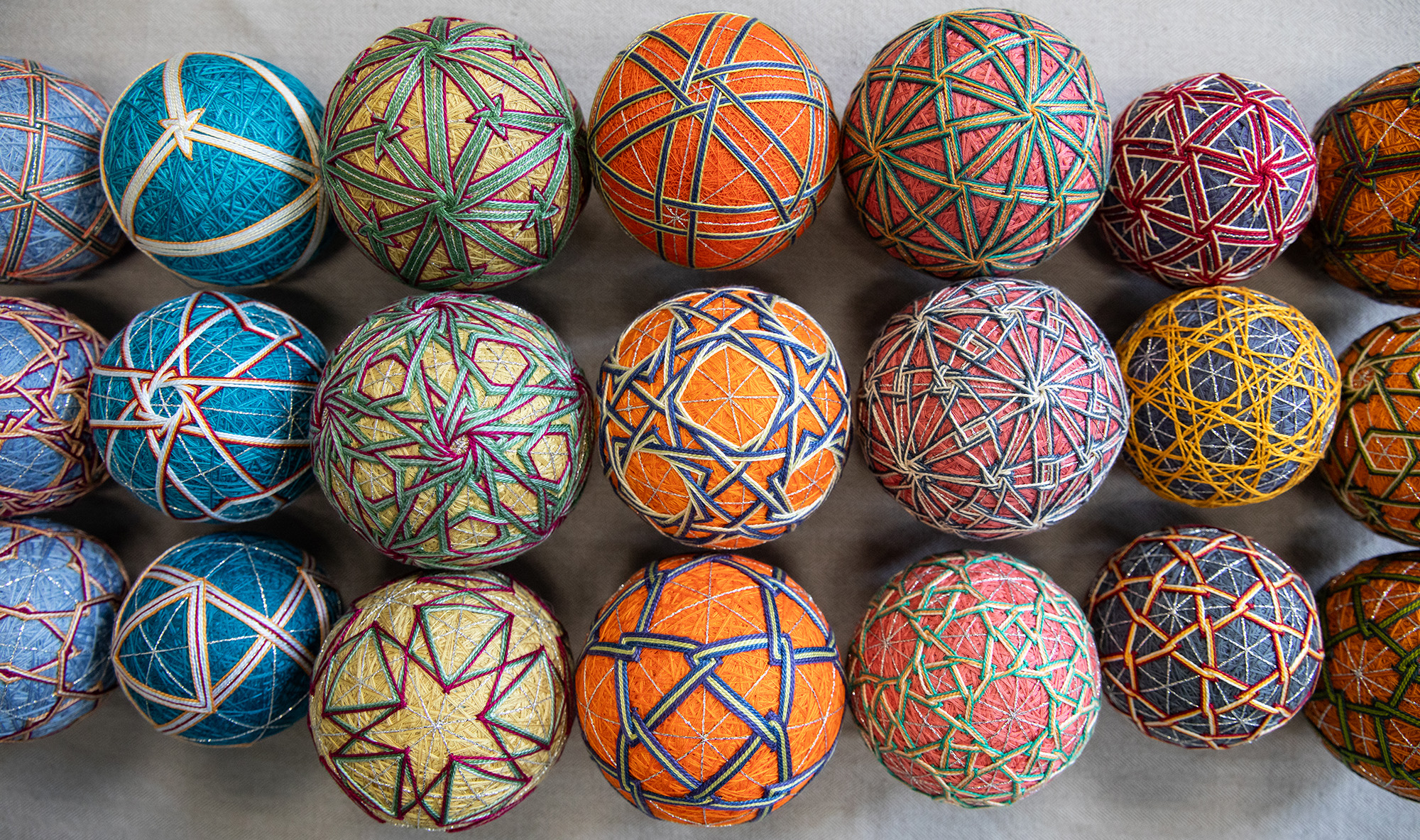
Carolyn Yackel, SB’92, intricately embroidered temari balls to represent each of the 13 Catalan solids three different ways. (Photography by Christopher Ian Smith)
Carolyn Yackel, SB’92, weaves together math and fiber arts.
I’ve never been in the fashion show before,” says Carolyn Yackel, SB’92, flipping through digital photos of herself sporting brightly dyed, handsewn garments—a red pleated skirt, a blue sarong, a pink tunic. She’ll get to show off some of these pieces on the runway at the annual Bridges conference for mathematics and the arts.
Yackel, a math professor at Mercer University, dyed these fabrics using the Japanese itajime shibori technique to reproduce wallpaper groups, a mathematical classification system that describes symmetry patterns. An expert in mathematical art, she works in different fiber arts—shibori, temari, and knitting among them—exploring mathematical problems through the unique constraints of each craft.
Raised by two mathematicians, Yackel incorporated math into creative play from an early age. And when her grandmother taught her to crochet, she found joy in deciphering complicated instructions and puzzling out how to correct mistakes. She brings this same curiosity to her research today—starting from questions of how and to what extent she can reproduce a mathematical concept in a handicraft.
Her research often revolves around symmetry, which Yackel has been drawn to since childhood: “My mom used to tease me when I was a little kid. Like with blocks, I would always make these really symmetrical arrangements and be like, ‘Please come take a picture of this!’”
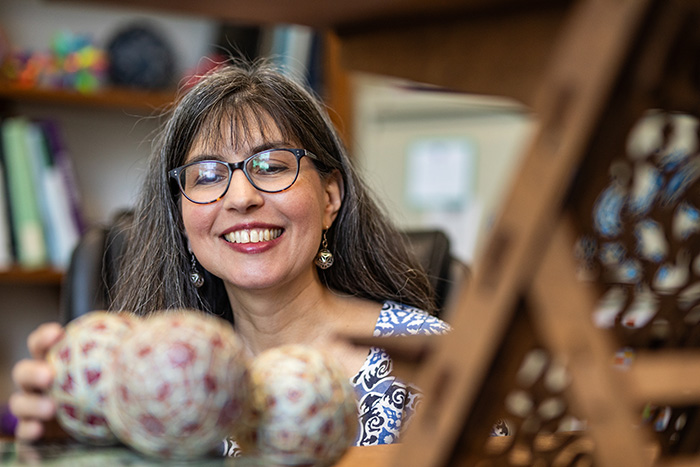
Yackel is part of a small but passionate mathematical art community. In 2001 she cofounded a knitting circle at the Joint Math Meetings, the American Mathematical Society’s major annual conference, where she and her compatriots have now gathered for 25 years. The circle’s meetups have led to several special sessions at the Joint Math Meetings as well as a special issue of the Journal of Mathematics and the Arts and three books, all of which Yackel coedited. In the books, readers can explore all manner of concept and craft—socks with algebraic structure, group actions in cross-stitch, Gosper-like fractals and intermeshed crochet, tessellations and quilting.
Next year a new journal dedicated to mathematics and fiber arts, Interlace, coedited by Yackel, will publish its first issue, providing another forum for this research. Yackel hopes the open-access journal will make questions at the intersection of math and art accessible to those outside the academic math community, allowing as many people as possible to engage with these new ways of understanding and describing—and creating—the world around us.
It’s a mathematical outlook that many share, even if they don’t realize it. As Yackel writes in the dedication to her 2008 edited volume, Making Mathematics with Needlework: Ten Papers and Ten Projects, “To my grandmothers, who were excellent needleworkers but didn’t know they were mathematicians.”
Read on to learn how Yackel brings together math and art.
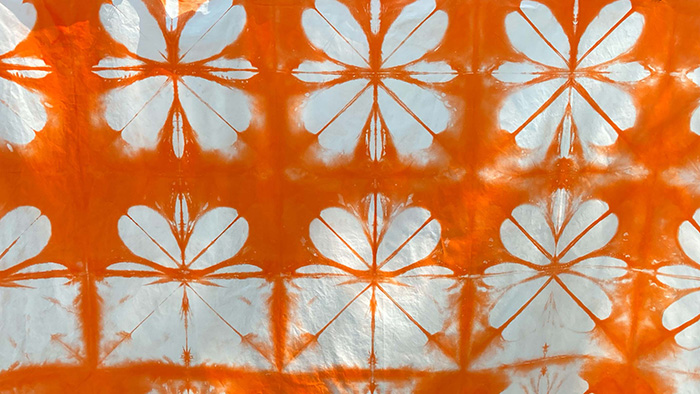
Into the fold
“I dreamt of all the symmetry types I would produce using shibori, even before I had tried the technique,” writes Yackel in the introduction to a 2021 paper about reproducing mathematical wallpaper symmetry groups on handkerchiefs through the shibori fabric dyeing technique.
For this project, Yackel chose itajime shibori, a kind of shibori that involves folding fabric and applying “resists” to prevent the dye from penetrating certain areas of the textile. Traditional resists might be made from pieces of wood; in Yackel’s case, coins and washers secured with binder clips worked just fine. She wanted to understand how many of the 17 total wallpaper symmetry groups she could re-create with this dye process.
You can think of wallpaper groups as all possible patterns you would get from orienting a patterned tile in different ways across the floor. One, for example, involves simple translation: You keep the tiles oriented the same way as you place them in horizontal and vertical rows. Some wallpaper groups exhibit reflection: The tile is mirrored across a vertical or horizontal axis (or both). And others involve rotational symmetry, or turning your tile by, say, 90 degrees.
Some of the wallpaper groups were immediately out because they can’t be reproduced in three-dimensional space (they would require passing a handkerchief through itself). And others, which would require creating cone points, were also impossible without cutting the fabric. Given these constraints, Yackel was able to reproduce seven of the wallpaper groups. The fabric above (out of which Yackel later sewed an apron) has a wallpaper pattern that involves a pattern repeat over an isosceles right triangle, where the pattern reflects across each side of the triangle.
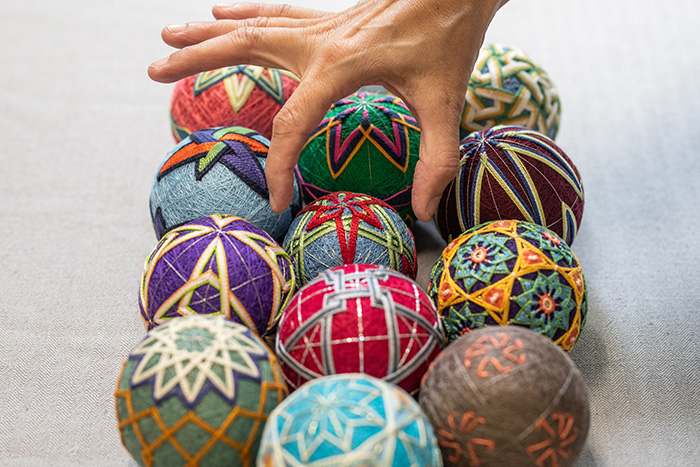
Dualing solids
Temari, a Japanese folk art of intricately embroidered balls, evolved from handmade balls used centuries ago for a game akin to hacky sack. Today the core of the balls is made of scrap fabric or Styrofoam, which is wrapped in fabric batting and then in layers of thread. Guidelines—threads laid down at even distances measured with a strip of paper—then set the stage for geometric patterns to be stitched around the ball.
“One of the things that’s considered really beautiful about temari balls is when you make these symmetric motifs all around the ball. And you just don’t have a shot at doing that unless you make some lines on your canvas,” says Yackel. For those with a mathematical eye, the guidelines used in temari naturally generate Platonic solids. These are five three-dimensional shapes—the tetrahedron, cube, octahedron, dodecahedron, and icosahedron—made of the same regular polygons, which meet at identical angles at the vertices. As you embroider symmetric designs around a temari ball, it’s common for both a Platonic solid and its dual—a kind of counterpoint shape—to emerge. A solid’s vertices correspond to the midpoints of its dual’s faces (and vice versa), and the two shapes share the same number of edges: The cube and the octahedron, for example, are duals.
Just as there are 17 wallpaper groups, there are 14 discrete spherical symmetry groups. Yackel and her frequent collaborator sarah-marie belcastro proved that you can represent all of them using temari balls (above). Six involve dual Platonic solids projected onto the surface of the ball. Seven exhibit frieze patterns—symmetric patterns that repeat in a line, as do many friezes along the roofline of a building—wrapped around the ball. A “bonus ball” features patterns reflected over the edges of an octahedron.
They found that while all spherical symmetry groups were possible in temari, this mathematical classification system wasn’t a sufficient way to describe the art form: Two balls could exhibit the same symmetry even while representing different solids. As a result of the project, they proposed a more precise classification system for spherical symmetry in temari.
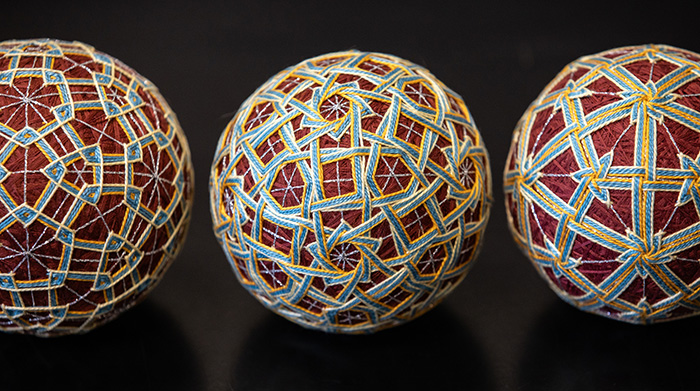
Temari, and temari, and temari
Yackel’s latest project involves projecting the 13 Catalan solids onto temari balls (above). Catalan solids are the duals of Archimedean solids (on which the same number of regular polygon faces meet at each vertex; unlike Platonic solids, the faces of Archimedean solids do not need to be the same shape). This work started as part of Mathemalchemy, a traveling exhibition of whimsical math-related art—including a cryptographic quilt, a knit tortoise with heptagonal tiling on its ceramic shell, and a cat serving pi-shaped cookies—created by a team of 24 mathematicians and artists. For the exhibition, Yackel designed two giant arches made of more than 120 temari balls, some of them embroidered with Catalan solids.
Since working on Mathemalchemy, Yackel has expanded her treatment of Catalan solids on temari balls, creating three balls to depict each solid, each using a different stitch pattern. On one ball she outlines each edge of the solid; on the next she outlines each face; and on the last she connects the midpoints of the edges. The third technique has produced some weird results, especially because choosing to make a stitch on one side of a piece of thread versus the other side can completely throw off the ball’s symmetry. Some of these balls have turned out a little chaotic from an artistic perspective, Yackel admits, but they are perhaps even more mathematically interesting: In connecting the midpoints of edges, she has created some truncated solids—what you get when you chop off the points of a Catalan solid—generating a new set of faces.
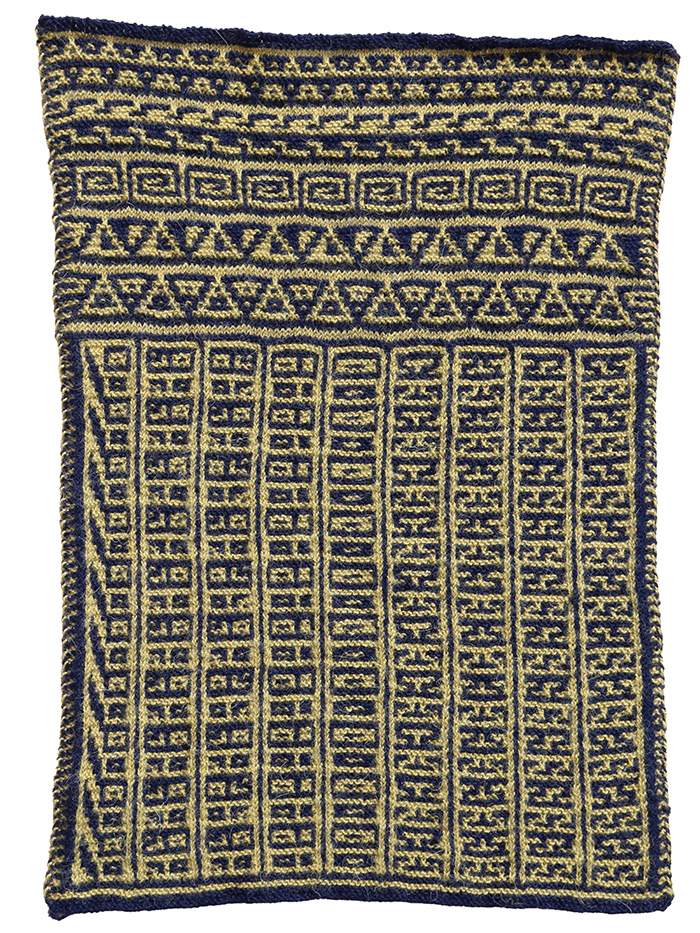
Spin a yarn
There are multiple ways to create colorful patterns with knitting. Stranded color work, also called Fair Isle knitting, involves working multiple colors within the same row, and carrying the yarn not in use across the back of the work—these strands are called floats. If not “caught” properly—tacked down by your working yarn every few stitches—you can end up with a floppy mess on the back of your sweater.
A color work technique called mosaic knitting avoids this unfortunate situation. Mosaic knitting involves working one yarn color per row, using slipped stitches to pull a color up from one row to the next. You end up with colorful patterns on the front of your work (the right side), and a neat wrong side with fewer floats.
Yackel and her collaborator Susan Goldstine set out to make mosaic knitting not only neat but also symmetrical. One thing they wanted to know was if they could reproduce all 17 two-color frieze symmetries. But they found that the rows of alternating working color and slipped stitches that characterize mosaic knitting introduced some complications.
Three of the frieze symmetries proved impossible to produce with mosaic knitting, either because the slipped-stitch technique constrains how colors stack on top of one another or because they would require some stitches to be two colors at once. The wall hanging Float Free, Bumblebee (above), which Goldstine knitted, exhibits the 14 attainable two-color frieze symmetries.
